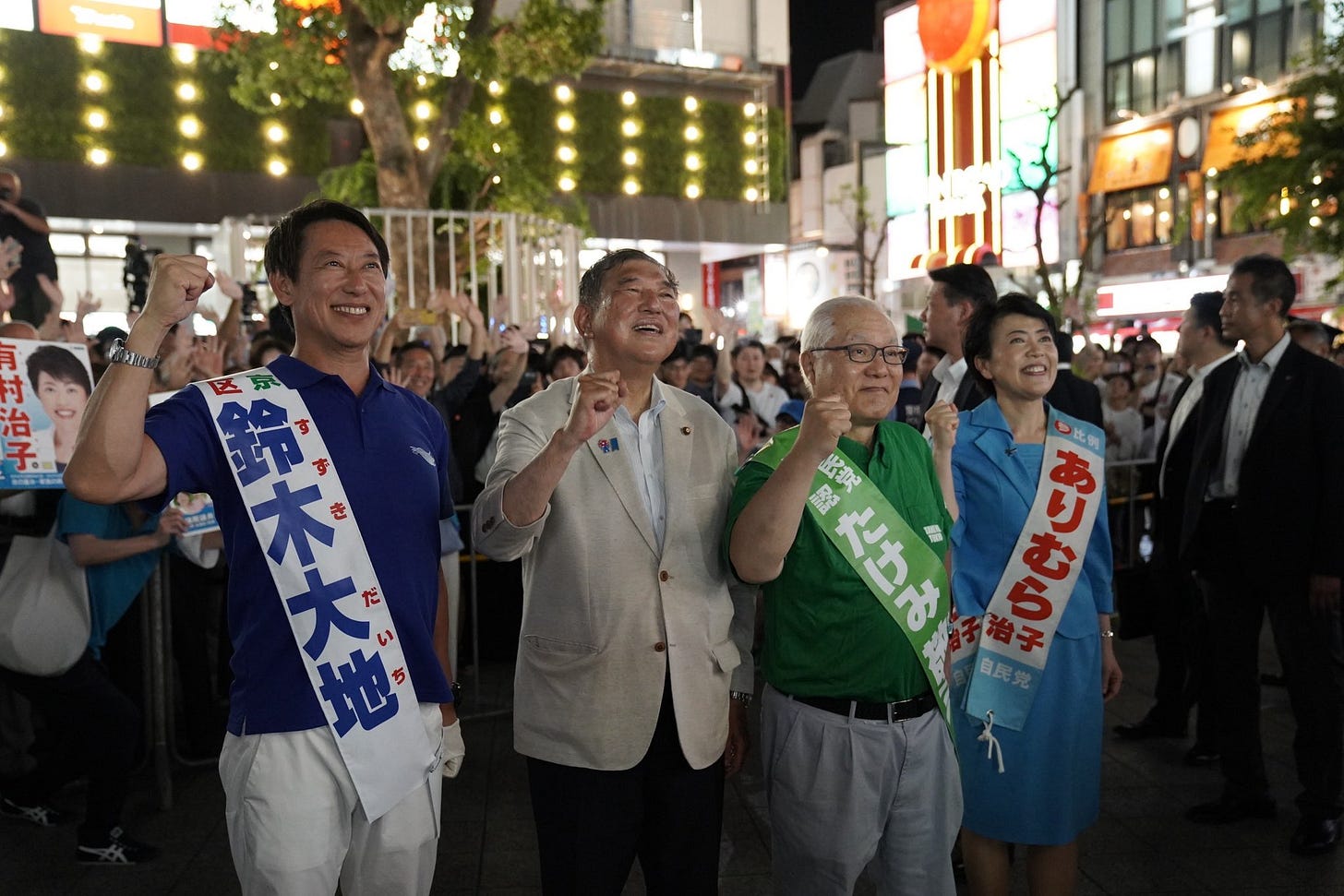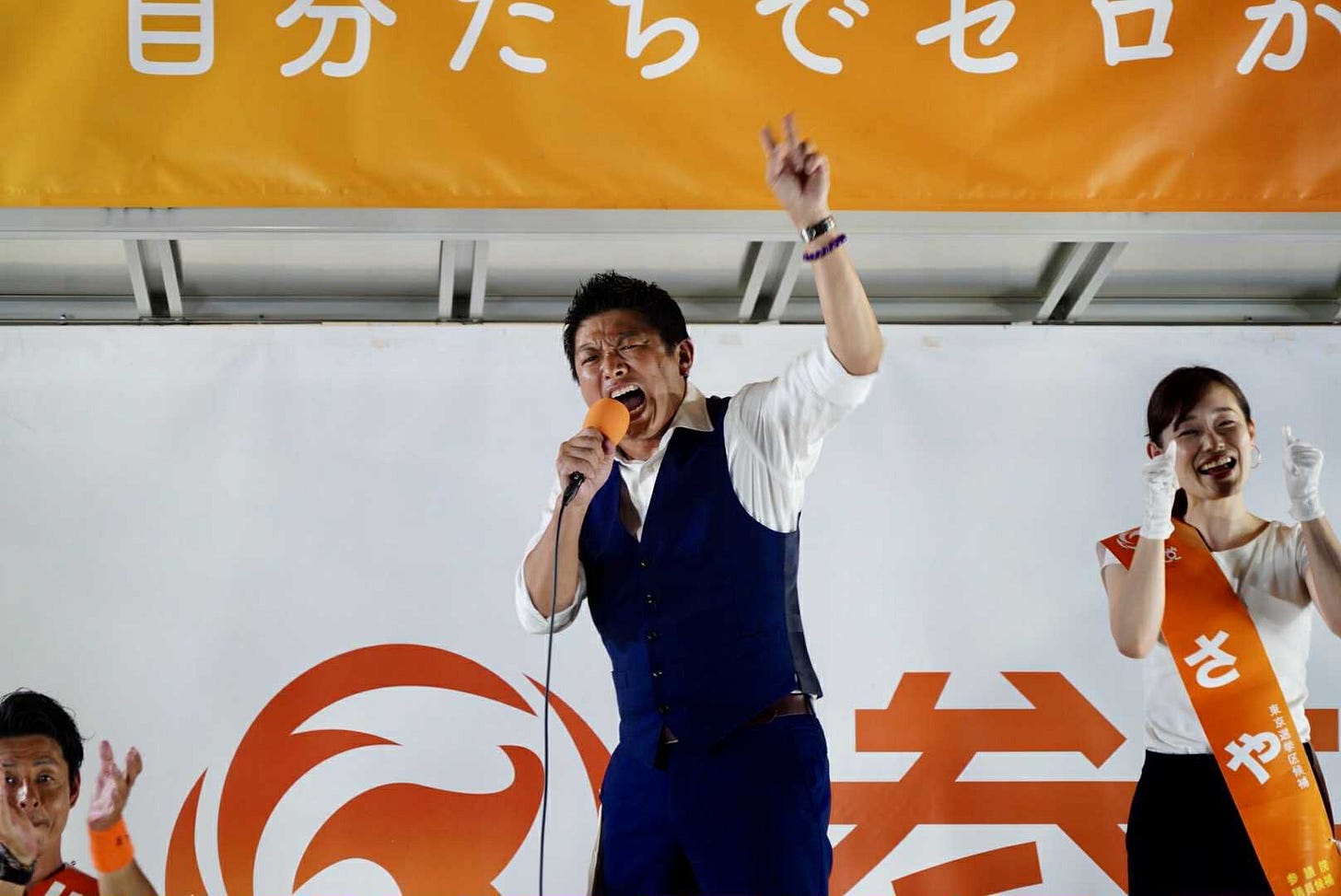Fear, anger, and responsibility | Today in the Upper House Campaign
The new populism and the future of Japan's politics
Today’s edition, the last before Japan votes, will be available to all subscribers.
A pdf of my viewer’s guide to the upper house elections — available to paid subscribers here — can be purchased here.
If you are looking for timely, forward-looking analysis of the stories in Japans’s politics and policymaking that move markets, I have launched a new service through my business, Japan Foresight LLC. For more information about Japan Foresight’s services or for information on how to sign up for a trial or schedule a briefing, please visit our website or reach out to me.
Paid subscribers will be able to join a Substack chat following the results in real time here. I will also be posting updates on Bluesky.
In case you missed it, I published a post earlier today on the key questions heading into election day.
Campaign notes
Fear, anger, and responsibility

Prime Minister Ishiba Shigeru, on the brink of an election that could decide whether he is able to carry on in his job, ended his campaign with a rally alongside the Liberal Democratic Party’s (LDP) two candidates in the Tokyo multi-member constituency outside Kamata Station in southern Tokyo, far from Akihabara Station in central Tokyo, where Abe Shinzō would hold his “final night” rallies after his return to the LDP’s leadership in 2012.
Perhaps the geographic remoteness speaks to Ishiba’s growing political isolation, the increasingly unpopular leader whose own party has sought to distance itself from him as the campaign has proceeded. It would, at this point, take an extraordinary and unexpected shift for the prime minister to survive Sunday, a veritable “Dewey defeats Truman” moment that would take its place in Japanese political lore.
To pull off the improbable, Ishiba in his final speech returned to what has been the main thread running through the LDP’s campaign: the LDP (and implicitly Komeitō) is the only party that can be trusted to govern responsibly in a dangerous world. In many of his stump speeches, Ishiba has talked about Russia’s invasion of Ukraine and North Korea’s participation in the war, usually before he pivots to talking about the more quotidian issues that are higher priorities for most voters.
Saturday was no different. After introducing the candidates, Ishiba immediately began discussing Russia’s invasion, North Korea’s cooperation with Russia, and North Korea’s ballistic missiles.1 He eventually began discussing the debate over the rising cost of living, wages, and the economy, but, having warned about the dangers that surround Japan, he then discussed risks closer at home related to Japan’s aging society and the stresses it will place on Japan’s social security system, saying that while other parties are talking irresponsibly about halving or eliminating the consumption tax, only the LDP is willing to talk seriously and forthrightly about how to confront the challenges facing Japan. “These kinds of policies cannot be called policy,” he said. Ishiba, describing what he referred to as the “politics of irresponsibility,” said:
Right now, all sorts of things are being said. “As long as things are good now, it’s fine. As long as we’re okay, it’s fine.” In politics, this kind of thinking is tempting, but [if it happens] the nation will surely decline.
Implicitly answering Constitutional Democratic Party (CDP) leader Noda Yoshihiko’s accusation that Ishiba’s government is a “do nothing” government, the prime minister is arguing that there is wisdom and security in resisting the temptation of the politically expedient and doing harder, unpopular things instead.
The bottom line, delivered by Ishiba, is that if voters succumb to the temptation of the short-term fixes offered by the opposition, they will trigger a political crisis that will not only leave Japan vulnerable to growing threats that surround it today but will also leave the country less secure over the long term. Other senior LDP leaders, from Asō Tarō to Koizumi Shinjirō, delivered virtually identical messages to voters in their own stump speeches during the final days of the campaign. It’s a dangerous world, and the opposition parties are too irresponsible to pilot Japan safely through it. This is not a new appeal – Abe always reminded voters of the bad, old DPJ years and warned them of the risks of handing power back to them – but rarely has the LDP’s campaign been as pared down to this message as it has been during this campaign.
—

If Ishiba and his party are relying on fear to bring voters back, the parties campaigning to break the government’s upper house majority and drive Ishiba from power are relying on a different emotion: anger.
The anger has different targets and has been channeled by different parties in different ways, though virtually every party has tried to tap into popular anger at the rising cost of living against an LDP that not only has allowed the problem to worsen but has essentially feathered its own nest through its avoidance of campaign finance restrictions. Perhaps no party has tapped into popular anger more than Sanseitō, which, as Leo Lewis argues in the Financial Times, has found a rich vein of anger that can be traced back to the weak yen, which has not only eroded household incomes but has also made Japanese feel like second-class citizens in their own country as foreigners purchase real estate, crowd into restaurants, and overwhelm communities. Arguably what these parties are tapping into is the changes that have fueled a cottage industry of books with titles like Poor Japan and Poor Country Japan and articles warning that Japan is becoming a “developing country” as it slides down international rankings.2 Sanseitō’s scapegoating of Japan’s foreign population – the party’s accusations about law-breaking foreigners have been thoroughly debunked – is as misdirected as it is familiar, but the feeling that the country has fallen behind and the LDP-led government has done nothing to stop is felt beyond the party’s swelling ranks.
For anyone who has followed politics in the developed world over the past decade, this clash – an embattled establishment warning of the dangers of handing power to irresponsible populists, versus outsider anti-establishment politicians drawing on popular anger and giving voice to voiceless – is all too familiar. And it makes it difficult to believe that Ishiba, who has struggled to restore public trust from the moment he stepped into the premiership, will be able to hold back this tide of anger.
—
Whether or not the ruling coalition is able to prevail on Sunday, Japan’s leaders will still have to navigate Japan’s new populism. Japan, after all, has not been as immune to populism as conventional wisdom suggests. It had its populist waves earlier – the reformist parties of the 1990s, Koizumi’s revolt against the LDP establishment in the early 2000s, and in its way the DPJ under Ozawa Ichirō from 2006-2009, as well as bureaucrat bashing throughout the Heisei era – and its populism lacked the xenophobia of American and European populism and has been an urban, rather than a rural phenomenon. Japan’s new populism, like the old populism, remains an urban phenomenon, but now has foreigners to target too, both Japan’s largest-ever population of foreign residents and a seemingly bottomless supply of foreign tourists, many drawn from Asia’s new middle classes. This new wave is arguably still in its infancy, and whether Sanseitō is its vehicle or whether it succumbs to some of its obvious vulnerabilities, the impact of popular anger at the LDP-dominated political establishment will continue to shape Japanese politics for years beyond this election. At some point, Japan’s leaders have to grapple with their country’s own “democratic deficit,” precisely because of the challenges that Ishiba stressed on the campaign trail. As I wrote in Nikkei Asia early in the campaign:
It is precisely because of the extraordinary challenges that Japan faces at home and abroad that it has never been more imperative for Japan's political leaders to reckon with the state of Japanese democracy and to ask whether the system is capable of securing the consent – and, more importantly, the trust – needed to make hard choices on behalf of the people.
The campaign trail
Prime Minister Ishiba Shigeru ended the campaign with stops in Miyagi and Tokushima before returning to rally at Kamata Station in Tokyo. Koizumi Shinjirō stopped in Oita and Tokyo before finishing his campaign in his home prefecture of Kanagawa. Kobayashi Takayuki started in Miyagi and finished Chiba, his home prefecture.
Komeitō leader Saitō Tetsuo campaigned in Saitama and Chiba.
Constitutional Democratic Party (CDP) leader Noda Yoshihiko campaigned in Niigata, Tokyo, and Tochigi before finishing with an evening rally in Fukushima, a single-member constituency that the CDP is hoping to flip. CDP Secretary-General Ogawa Junya was in Saitama, Ibaraki, and Tochigi.
Tamaki Yūichirō, leader of the Democratic Party for the People (DPFP), campaigned in four prefectures on Saturday, starting in Fukuoka and then stopping in Kanagawa, Chiba, and Saitama before concluding with a rally outside Shimbashi Station in Tokyo.
Ishin no Kai’s Yoshimura Hirofumi started in Tokyo before campaigning in Hyogo and Osaka.
Sanseitō’s Kamiya Sōhei campaigned in Kanagawa, Gunma, Saitama, Ibaraki, and Chiba before returning to Tokyo for a rally in the shadow of Tokyo Tower at Shiba-kōen.
JCP leader Tamura Tomoko was in Tokyo.
He did not make the connection to Sanseitō’s alleged ties with Russia, although perhaps he did not need to.
Once you notice this trope, you start seeing it everywhere.




